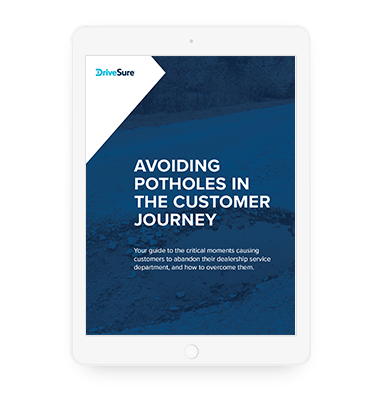This article was originally posted to DrivingSales.com.
It seems obvious: Customers tell you what they like or don’t like. Your dealership does more or less of those things. At a basic level, that’s right. But dealerships need more intentionality when it comes to customer feedback. They need to be able to take action and show their customers they’re committed to continual improvement and listening.
That’s where customer feedback loops enter the picture.
A customer feedback loop is an approach to gathering insights on a continual basis, so your dealership can keep its finger on the pulse of your customer base and improve its overall experience. Many dealerships send surveys or have casual conversations with their customers. Customer feedback loops take these efforts to the next level to ensure you’re constantly receiving and responding to customer feedback.
As we’ll talk about later, the key point for a successful customer feedback loop is “responding.” Without meaningful action from your dealership – aka closing the loop – it fails to be a feedback loop at all.
Let’s take a closer look at customer feedback loops and why your dealership should have one.
Prepare for the 5 make-or-break moments that can cause service customers to start going elsewhere.
The Importance of a Customer Feedback Loop
Customer feedback loops drive loyalty and retention. Customers want to know they have a voice at your dealership and that you’re willing to listen to them. Show them you’re all about taking action to improve their experience and they’ll keep coming back. They’ll also tell their friends and family to buy from your dealership.
“Customer feedback is the breakfast of champions.”
– Brian Halligan, co-founder of HubSpot & globally renowned business leader
Customer feedback loops are important to dealerships because they establish a scalable system for making customers feel heard. They go beyond merely asking for feedback; customer feedback loops end with a solution and an affirmation to the customer that their thoughts led to a positive change.
Customer feedback loops are essential because customer loyalty is essential. Their value is that simple.
The Stages of a Customer Feedback Loop

1. Gather: Surveys are a natural starting point for gathering data. Using a survey platform to do this can be beneficial because they’re easy to build and share – and they sometimes offer instant analysis of the results. Gathering feedback can be done via email, dealer management systems, live chats, and even social media.
Understanding when to source customer feedback is the key at this stage.
Think about the different touchpoints where a customer is most likely to have an emotional response (good or bad) to your dealership. At what points in their visit are customers deciding to buy or not? At what points are they deciding they’ll return or not?
An example strategy for gathering data in a customer feedback loop may begin with a survey about a service visit. You set up an automation, likely using an email integration with your dealer management system, to send each service customer a satisfaction survey one hour after their visit. Once the customer completes the survey, another automated email is sent to them as a “thank you” for their time – potentially including a small dealership store credit.
While this outreach can be done manually, it’s a huge challenge to scale. Just like with requesting customer reviews, automated email campaigns are effective and easy to create.
2. Analyze: Once you’ve gathered enough data to make reasonable conclusions about your customer satisfaction, it’s time to analyze. Your dealership may also consider setting up a quarterly cadence for performing these analyses. First, break out your customer feedback by category – for example, service insights vs. sales insights. Then, your dealership can review feedback in an intentional and actionable way.
Hopefully the tools you’re using have built-in analytics. Either way, you’re looking for common themes here. Are you receiving the same complaints about service wait times? Do customers rave about the same salesperson? These are the kinds of questions you’ll ask yourself as you analyze customer feedback.
3. Implement: As mentioned earlier, this fails to be a “loop” without action from your dealership. That means implementing insights from your customer feedback – or closing the loop – through solutions. If you’ve determined a need, such as decreasing service wait times, start working towards a strategy with your team.
An important point at this stage is to communicate with your customers. Set the tone that your dealership is dedicated to their satisfaction by letting them know a solution is in the works as a result of their feedback. Once the solution has been implemented, again make sure customers know that it was a result of their feedback.
Action and communication fuel customer feedback loops (and thus loyalty).
4. Revisit: Without customer feedback loops, old problems can quickly become new problems. In the analyze stage, watch out for common customer complaints that have returned. Track the performance and reception of new solutions. Ask your customers in the gather stage for their thoughts on the solutions you’ve already implemented as a result of their feedback. As the name suggests, customer feedback loops depend on constant connection throughout the stages.
Closing a Customer Feedback Loop
The benefits and stages of a customer feedback loop are all well-documented. But as you read more about this topic, you’ll run into the idea of “closing” your customer feedback loop.
Wait, why would you want to close your customer feedback loop?
Closing the customer feedback loop simply means you’ve notified customers a change has been made to your dealership’s offerings directly based on their feedback. Going back to the main theme of customer feedback loops, you’re putting a cap on the process by telling them they were heard. You’re telling them their feedback mattered.
Ready to kickstart and close your customer feedback loop?
Get this guide to the customer journey first, so your dealership can better understand the most common moments dealerships lose customers. These are great places to start focusing on feedback.
Master These Moments to Keep Your Customers
Discover the 5 critical moments causing customers to abandon your dealership service department, and how you can overcome them.


